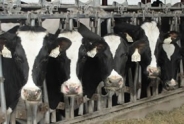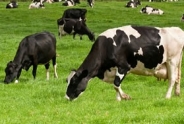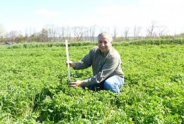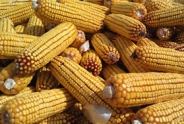A Possible New Technique To Monitor Soil Compaction
A. Fay Benson, Small Dairy Extension Educator
South Central New York Dairy & Field Crops
AG PUBLICATIONS Article EDITED DRAFT 1-24-22 - 1/27/2022 kd
A POSSIBLE NEW TECHNIQUE TO MONITOR SOIL COMPACTION
By Fay Benson, Cornell Cooperative Extension of Cortland County
A Northeast Sustainable Agricultural Research and Extension (NESARE)-funded project conducted by Cornell educators has begun evaluating a possible new technique for monitoring and managing soil compaction specifically in pastures. This article provides a summary of that project; the results may have implications for future use in managing pastures and other types of production land.
Permanent pastures for livestock can have some of the healthiest soils due to the fact they provide the four principles described by the Natural Resources Conservation Service to achieve a healthy soil: Maximize Soil Cover, Maximize Living Roots Year-round, Maximize Plant and Animal Diversity, and Minimize Soil Disturbance. One weak spot for some pastures is soil compaction,
Soil compaction reduces the spaces between soil particles causing the soil to become denser. Theoretically, the volume of the soil is 50% pore space, 45% mineral particles (sand, silt, clay), and 1-5 % organic matter. When compacted, total pore space and the large pores (macro pores) are reduced, which has negative effects on soil biological functions, water transmission, and root elongation.
With pasture, once grazing season arrives, livestock go into the pastures no matter the weather. Whether cows, horses, or small ruminants, the weight of the animal compared to the size of the hoof can exert more compaction than a tractor. Further, plants that can live in compacted soils are not as productive due to shallow roots and are often not palatable to the livestock.
Not managing compaction over many years causes a very slow and damaging effect on the functions of the soil and the species that make up your grazing sward, reducing the productivity of your pastures. What I learned from my three-study is that although compaction is unavoidable, a change in management will quickly remedy it. This three-year NESARE-funded study revealed that soil compaction will dissipate within months if management changes and has provided a basis for developing those changes to enhance pasture productivity.
Method
The penetrometer is a readily available tool to easily measure soil compaction. When pushed into the soil, the penetrometer measures the soil's resistance. Its meter indicates the pounds per square inch (PSI) of resistance at the tip. One limitation of a penetrometer reading is that the resistance is highly affected by the soil's moisture status. A soil will have increasing resistance (or hardness) as a soil becomes drier. Therefore, one must consider a soil's moisture status when interpreting penetrometer results.
Per my interest in helping graziers monitor compaction in their pastures, I decided that it was best to use a side-by-side comparison with penetrometer readings from within the pasture vs. under the fenceline. Monitoring the compaction ratio between these two areas might be a useful tool to assess the effects of animal compaction and control for the natural soil type and changing soil moisture status. The ratio would monitor for any changes between an uncompacted area (fenceline) and the compacted area (pasture).
I decided to develop a ratio representing the unique conditions of pastures where the soil is impacted by grazing animals but the pastures' fenceline is not impacted by animal or machine-based compaction to determine if such a monitoring technique could be helpful. Monitoring with this Pasture Compaction Ratio (PCR) would look for any change between the optimum compaction area (fenceline) and the compacted area (pasture).
Plot Design:
To test my PCR hypothesis, I selected a 35-acre pasture continuously overgrazed by 40-60 beef animals. As expected in overgrazed pastures, there is increased traffic by the animals as they get only small bites from the sward that consisted of mostly bluegrass, Dutch clover and other forbs. The increased traffic leads to increased compaction. Due to the declining productivity of the pasture, the animals in the trial pasture mostly relied on stored hay brought into the pasture.
See Results and Discussion section of this report for changes made to the plot area as the project progressed.
Compaction Measurement and PCR
With the support of NESARE funding, my study collected penetrometer measurements over two grazing seasons on eleven paddocks and their adjoining fencelines on farms in New York State. The fenceline resistance reading was divided by the pasture resistance with the result a Pasture Compaction Ratio (PCR) for that day.
My hypothesis considered that even as the moisture changed, the change would happen equally between the two locations. What would change was if there was a worsening or improvement in compaction between the two locations. The study applied two approaches to prove this hypothesis. The first approach was to take the regular penetrometer readings and look for repeatability of the ratio as the moisture changed during the season.
How to Compute the Pasture Compaction Ratio (PCR) Using a Penetrometer collect five readings (lbs./sq. inch) of the top six inches of the pasture; these are averaged to determine Pasture Resistance. Divide the Pasture Resistance number by the average of five readings collected under the fenceline to determine Fenceline Resistance. Divide the Fenceline Resistance number by the Pasture Resistance number to determine the Pasture Compaction Ratio (PCR). PCR = Fenceline Resistance/Pasture Resistance.
Results and Discussion
ARE THE FIRST APPROACH READINGS FIG 1 and 2?
The first approach readings are shown in Figures 1 and 2. In the Paddock A and Paddock S graphs of pasture and fenceline measurements, and PCR ratio, you can see that even though the fenceline and pasture readings changed throughout the season the PCR remained fairly constant. There was enough variation, though, to require many more measurements to assess a degree of repeatability.
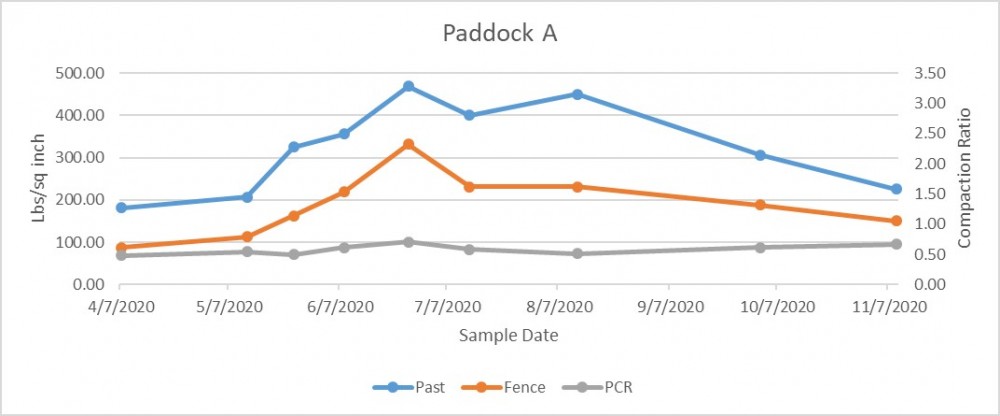
Figure 1. Pasture (Past) and fenceline (Fence) penetrometer readings and the resulting Pasture Compaction Ratios (PCR) for the Paddock A study area.
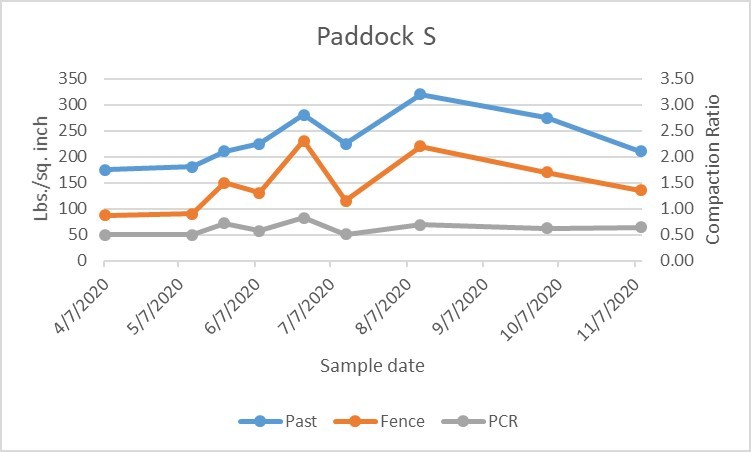
Figure 2. Pasture (Past) and fenceline (Fence) penetrometer readings and the resulting Pasture Compaction Ratios (PCR) for the Paddock S study area.
The second approach to testing the usefulness of the PCR was to change the management in a pasture and see if the PCR would monitor the change in compaction from the preceding management. To do this, I installed a ten-foot by ten-foot square enclosure within the previously selected 35-acre pasture that was continuously overgrazed by 40-60 beef animals. To mimic hay production within the enclosure, I cut the area to a four-inch height twice during the season. In 2019 and 2020, I took regular penetrometer readings of the enclosure and divided them into the fenceline readings to arrive at the enclosure's PCR. I continued to do the same for the pasture PCR.

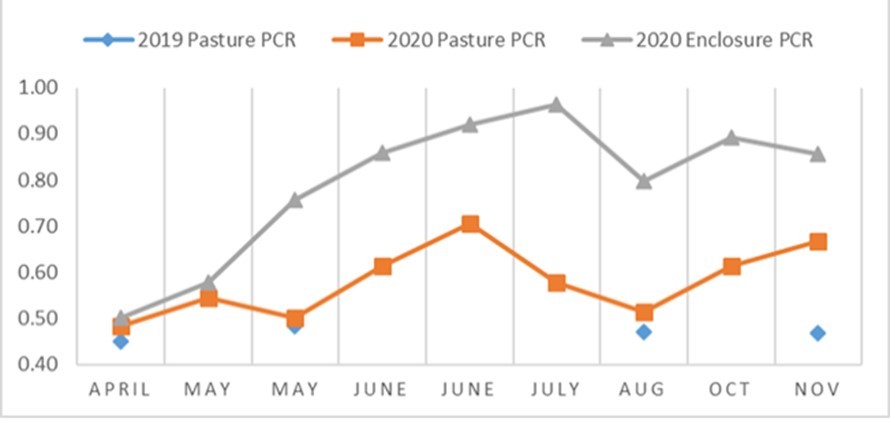
Figure 3. Comparison of Pasture Compaction Ratios (PCR) pasture vs. enclosure study areas in 2019 and 2020.
Discussion of the Graph
Each point on the graph above represents the ratio of the penetrometer readings for points in the pasture or enclosure and the fenceline. All readings were taken within a 30-foot circumference.
The Y axis shows the range of the PCRs. The highest point 1.0 would mean that the penetrometer reading for the pasture or enclosure, was equal to the fenceline for that date. A reading of 0.5 would mean that the penetrometer reading for the pasture or enclosure was two times the fenceline.
The X axis is the date of the penetrometer readings. There were fewer readings taken in 2019
Some of the interesting results shown in Figure 3 are as follow.
- The pasture PCRs for 2019 and 2020 are similar which would be expected since no management changes happened.
- The three PCR points in April of 2019 and 2020 were essentially the same. After May the enclosure's ratio increased and stayed elevated for the rest of the year. A rising ratio indicates less compaction and meant that the enclosure's soil resistance was moving closer to the fenceline's resistance.
- The separation of the two lines of PCR for the enclosure and pasture is an indication that the use of the PCR is capable of monitoring management changes. Switching the management within the enclosure to mimic hay production reduced the compaction of the soil. And the PCR was able to monitor how long it took to improve.
- I would have expected that the reduction in compaction in the enclosure would have shown up in April of 2020 due to frost and heaving of the soil. The reduction in compaction happening after the beginning of May indicates that possibly it occurred as a result of the pasture sward growing longer roots and/or the increase in soil temperature and biological activity causing the (aggregate) soil's air and water spaces to expand.
- I can't explain why the 2020 PCRs for pasture and enclosure deviate in August. Why did they both drop? It was suggested that the one measurement I failed to track was soil moisture. I assumed that moisture would change equally but if the pore spaces increase as the soil is less compacted that soil would have more water in those pores.
The reduction in compaction in the enclosure happened within a few months. What didn't change was the sward of bluegrass and other lower productivity species brought about by years of compaction in the pasture.
The fact that the shallow compaction caused by livestock will dissipate within months shows that properly managed grazing can maintain a healthy soil. The damage comes when compaction is left unchecked over many years with the result of lower productive grazing species entering the sward.
Project Outcome: Obviously, much more study is needed to better understand the usefulness of using a ratio between two soil management areas as a monitoring technique. This project provided a basis for more investigation into how quantifying and monitoring compaction over time can influence management decisions to improve pasture productivity. This project has raised more questions to be addressed before a PCR can be a reliable tool, but shows its promise for use to obtain monitoring data that can influence pasture management. Developing a way to monitor soil compaction with a readily available tool such as the penetrometer would provide a great advantage to graziers and potentially to other farmers and advisors who seek to improve the function and health of agricultural soils. Educational Outreach: Because soil compaction in pastures is unavoidable, Extension educators can offer the following immediate suggestions for reducing compaction on pasture and grazing lands:
- Graze mature swards. Benefits include deeper roots, longer rest periods, and denser bites so that the animal fills with fewer footsteps.
- Know the soil texture of your pastures. Soils high in sand and silt are more prone to compaction problems. Where these soils are, try to graze when soil is dry. A healthy texture would be equal amounts of sand, silt, and clay.
- Track your organic matter. Higher organic matter makes stronger soil aggregates or particles.
- Vary the use of paddocks where possible, e.g., start your grazing in different paddocks each spring, and allow paddocks to be harvested for hay at times.
Pasture management resources include "Pasture Soil Compaction: Prevention and Remediation," online and downloadable at https://projects.sare.org/wp-content/uploads/Compaction-Fact-Sheet-Final-1.pdf. A summary of this project has been distributed for use by agricultural media outlets.
Project Leader: Fay Benson is the NY Soil Health Trailer Coordinator, the education coordinator for the New York Dairy Grazing Apprenticeship Program, project manager of the NY Organic Dairy Initiative, and a small dairy support specialist with the six-county Cornell University South Central New York Dairy and Field Crops Team.
Cooperators: The following Cornell University and Cornell Cooperative Extension educators provided Input for this article: Joseph Amsili, Extension Associate/Soil Health Program Coordinator, Kitty O Neil, Ph.D, Field Crops & Soils Specialist/Team Leader: North Country Regional Ag Team; Janice Degni, Field Crops & Soils Specialist/Team Leader: SCNY Dairy and Field Crops Team.
Upcoming Events
Winter Bale Grazing Pasture Walk
January 10, 2026
Truxton, NY
Join us for the second Bale Grazing Winter Pasture Walk!
Have you heard about or seen bale grazing and wondered if it would work for you?
Do you want to learn the nuances and logistical context for implementing this regenerative practice?
Are you interested in seeing the impacts of bale grazing on land and animals from a practicing farmer?
If you answered Yes to any question, The Northeast Region National Grazing Lands Coalition, the Cornell Cooperative Extension Hillside Farms are teaming up to showcase our Second Bale Grazing Winter Pasture Walk!
Boots in the Barn: Webinar Series
January 13, 2026
Boots in the Barn: Cornell Dairy Research Updates
Webinar Series every Tuesday starting January 13th @ 12:00pm to February 24th.
2026 Winter Crop Meeting - Auburn
January 22, 2026
Auburn, NY
Connect with the agricultural community and many key note speakers on the folllowing topics:
- Emerging Innovation in Plant Breeding and Technologies - A Peek at the Future by Ben Rogers, Pioneer Field Agronomist
- Managing Herbicide-Resistant Weeds in NY Corn & Soybean by Dr. Vipam Kumar, NYS Extension Weed Scientist, Cornell University
- Livestock Risk Protection (LRP) Insurance Program by KC Slade, Risk Management Specialist, Farm Credit East—Crop Growers
- Birds & the Bees Legislation and the Fate of Neonics by Janice Degni, Extension Field Crop Specialist
- Emerging Disease Pests and Soil Borne Diseases of Soybean by Dr. Camilo Parada Rojas, NYS Extension Plant Pathologist, Cornell University
- Solar Farms—Benefit or Detriment? by Mr. Michael McMahon, Chair, Homer Town Planning Board
4 DEC credits in categories 1A and 21-25. 1.5 PM, .5 CM and 1 PD CCA credits available.
Please send your DEC license number in the Notes to Us when you register on-line.
Announcements
USDA Contract Freezes and Terminations: Legal Action Steps for Farmers
For Farmers with Signed EQIP and CSP ContractsThis resource is written for farmers and ranchers nationwide who have a signed contract with USDA NRCS under the EQIP or CSP program for environmental improvements but have concerns that their contract is frozen, under review, or terminated, and who are uncertain of their rights to receive reimbursement as well as their ongoing obligations under the signed contract.
Version: 1.0
Issue date: Feb 28, 2025
A downloadable factsheet is available at our BUSINESS tab on the top of our webpage.
Additional Information: www.farmcommons.org
USDA Contract Freezes: Filing an NAD Appeal or Demand Letter
This resource is written for farmers and ranchers nationwide who have a signed contract with USDA NRCS under the EQIP or CSP program for environmental improvements and want more information on the mechanics of filing a National Appeals Division (NAD) appeal. This resource includes sample letters.
USDA NAD Appeal https://www.usda.gov/about-usda/general-information/staff-offices/office-hearings-and-appeals/national-appeals-division/nad-appeals
Farm Participants Needed for Bale Grazing Grant!
Information on the Project:- Approximately 10 acres total needed to bale graze two different bale densities
- "Core" farms will graze two winters, "Demo" farms will graze one winter.
- Payments for both "Core" farms and "Demo" farms
- Baseline soil sampling by bale grazing team
- Forage measurements in early season by bale grazing team
- Late season clipping if residual not trampled down by farm
Cornell Cow Convos - New Podcast
On-going podcast, New episodes released on the last Thursday of the month.Guest speakers, CCE Dairy Specialists.
Housed on Soundcloud Channel is CCE Dairy Educators
- Preventative healthcare for cows
- The trend of beef on dairy
- What to look forward to in the new year for dairy
- Socially grouping or pair-housing calves
2018 Drug Residue Prevention Manual
For more than 30 years, the U.S. dairy industry has focused educational efforts on the judicious use of antibiotics through the annual publication of a Best Practices Manual. The 2018 edition of the National Dairy FARM Program: Farmers Assuring Responsible Management? Milk and Dairy Beef Drug Residue Prevention Manual is the primary educational tool for dairy farm managers throughout the country on the judicious and responsible use of antibiotics, including avoidance of drug residues in milk and meat.The manual is a quick resource to review those antibiotics approved for dairy animals and can also be used as an educational tool and resource for farm managers as they develop on-farm best management practices necessary to avoid milk and meat residues. Visit the Manual and Form Library to download copies of this important tool!
Follow us on Facebook
The team updates our facebook page frequently - follow us to be updated on our events, see some fun videos and get local area updates!facebook.com/SCNYDairyandFieldCropsTeam
NYSERDA Agriculture Energy Audit Program
NYSERDA offers energy audits to help eligible farms and on-farm producers identify ways to save energy and money on utility bills. Reports include recommendations for energy efficiency measures.For more information and the NYSERDA Agriculture Energy Audit Program Application click here

